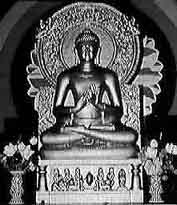
Page 1/3
T he extraordinary history of India is a result of its geography. Located between the East and the West, it has always been subject to invasion, while its natural isolation allowed it to adapt to and assimilate many of the peoples who penetrated the Himalayas. Despite the Persians, Greeks, Chinese nomads, Arabs, Portuguese, British and other invaders of India, native Hindu Kingdoms endured. India has always been too big, too complicated, and too culturally subtle to let any one empire dominate it for long.
India's most ancient civilization, one of the world's oldest, was known as the Indus. Dating back to 3000 BC, the Indus originated in the South and moved north, building complex, mathematically planned cities, most notably, Harappa on the Ravi river and Mohenjo-Daro on the Indus. The ancient cities had granaries, citadels, and even household toilets. In Mohenjodaro, a mile-long canal connected the city to the sea, and trading ships sailed as far as Mesopotamia. At its height, the Indus civilization extended over half a million square miles across the Indus river valley, and though it existed at the same time as the ancient civilizations of Egypt and Sumer, it far outlasted them.
 The first group to invade India were the Aryans, who invaded from
the north in about 1500 BC. The strong cultural traditions the
Aryans brought with them are, amazingly, still evident to this
day. They spoke and wrote in Sanskrit, the language used to
document the Vedas. Though warriors and conquerors, the Aryans
lived alongside the Indus, introducing them to the caste system and
establishing the basis of the Hindu religion. After about 700 years
in the northern regions, the Aryans then moved further south and
east and eventually settled the Ganges valley.
The first group to invade India were the Aryans, who invaded from
the north in about 1500 BC. The strong cultural traditions the
Aryans brought with them are, amazingly, still evident to this
day. They spoke and wrote in Sanskrit, the language used to
document the Vedas. Though warriors and conquerors, the Aryans
lived alongside the Indus, introducing them to the caste system and
establishing the basis of the Hindu religion. After about 700 years
in the northern regions, the Aryans then moved further south and
east and eventually settled the Ganges valley.
The second great invasion of India occurred around 500 BC, when the Persian kings Cyrus and Darius, conquered the ever-prized Indus Valley. The Persian influence in India was minimal when compared to the influence of the Aryans, since they were able to occupy the region for only about 150 years. The Persians were in turn conquered by the Greeks under Alexander the Great, who swept through the country as far as the Beas River, where he defeated king Porus in 326 BC. While the Persians and Greeks subdued the Indus Valley and the northwest, the Aryan-based kingdoms in the East continued to develop.
During the decline of the Greek Empire, King Chandragupta swept
back through the country from Magadha (Bihar) and conquered his
way well into Afghanistan. This was the beginning of one of India's
greatest dynasties, the Maurya. Under the great king Ashoka
(268-31 BC), the Mauryan empire conquered nearly the entire
subcontinent, extending itself as far south as Mysore.
 When Ashoka conquered Orissa, however, his army shed so much blood
that the repentant king gave up warfare forever and converted to
Buddhism, a religion founded in the 5th century BC by Siddhartha
Gautama. An incessant and steadfast missionary, Asoka brought
Buddhism to much of central Asia. His rule marked the height of
the Mauryan empire, which collapsed only 100 years after his
death.
When Ashoka conquered Orissa, however, his army shed so much blood
that the repentant king gave up warfare forever and converted to
Buddhism, a religion founded in the 5th century BC by Siddhartha
Gautama. An incessant and steadfast missionary, Asoka brought
Buddhism to much of central Asia. His rule marked the height of
the Mauryan empire, which collapsed only 100 years after his
death.
After the fall of the Mauryan Empire, the regions it had conquered divided into many kingdoms and smaller dynasties. The Greeks returned briefly in 150 BC and conquered the Punjab. By then Buddhism had become so influential that the Greek king Menander rejected the Greek gods and become a Buddhist. The local kingdoms enjoyed relative autonomy for the next few hundred years, occasionally fighting (and often losing to) invaders from the north and China.
In AD 319, Chandragupta II founded the Imperial Guptas dynasty, which conquered and consolidated the entire north and extended as far south as the Vindya mountains. When the Guptas diminished, a golden age of six thriving and separate kingdoms followed. At this time some of the most incredible temples in India were constructed in Bhubaneshwar, Konarak, and Khahurajo. It was a time of relative stability, and cultural developments progressed on all fronts for hundreds of years, until the dawn of the Muslim era.
The background, buttons and accessories appearing on this page are copyright material.
Copyright © 1997 JoPreetha Creations. All Rights Reserved.